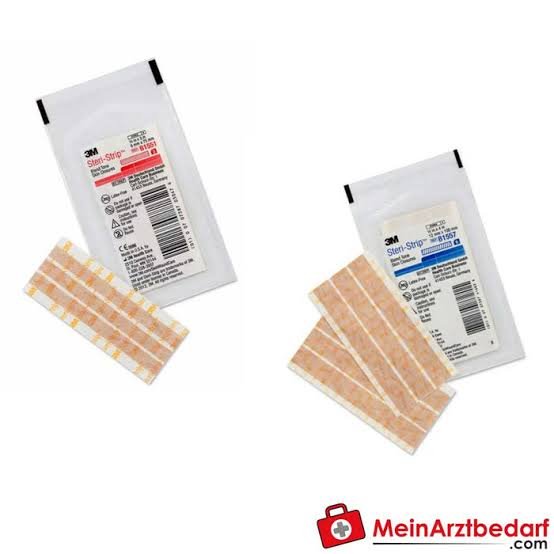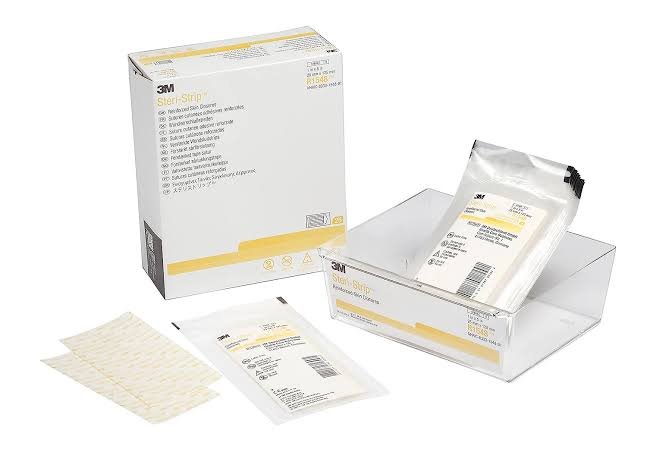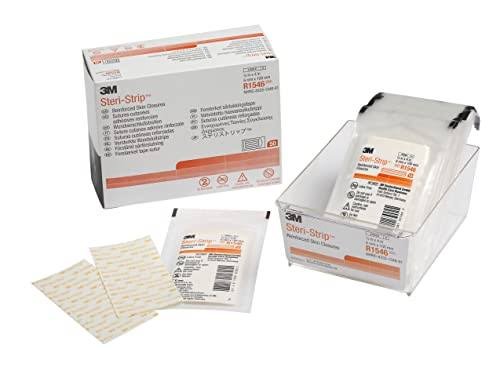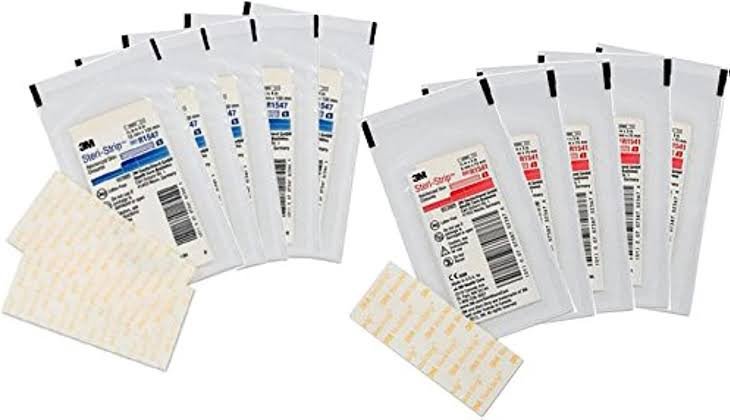When it comes to treating wounds, finding the right method for closure is crucial. From minor cuts and lacerations to surgical incisions, proper wound closure not only promotes healing but also minimizes scarring and reduces the risk of infection. In recent years, a game-changing solution has emerged in the world of wound care – Steri Strips!
These simple yet effective adhesive strips have been hailed as a revolutionary alternative to traditional stitches or staples. But how exactly do they work? What are their advantages over other methods? And most importantly, how can you ensure that you’re using them correctly for maximum effectiveness? Get ready to dive into the secrets behind Steri Strips and uncover a whole new world of efficient wound closure!
How Do Steri Strips Work?

Steri Strips are a versatile and effective tool for wound closure. But how do they actually work? Let’s delve into the secrets behind these tiny adhesive strips!
At their core, Steri Strips function as external sutures, providing support and tension across the edges of a wound. When properly applied, they help to keep the skin in close proximity, promoting faster healing and reducing scarring.
The magic happens when you carefully apply the Steri Strip over your clean and dry wound. As you gently pull the skin together, it creates a tension that helps bring the edges closer. The adhesive on the strip then secures everything in place.
But what about wounds that have already been closed with stitches or staples? Well, Steri Strips can still play a valuable role in these cases too! They act as an additional layer of support to reinforce the primary closure method.
One important thing to note is that Steri Strips are not meant for every type of wound. They work best on small cuts or incisions with minimal tension. For larger or deeper wounds that require more significant closure power, other methods may be necessary.
Steri Strips work by providing external support and tension to aid in wound closure. Whether used alone or alongside other techniques, they can be an excellent option for many types of minor injuries. So next time you find yourself facing a small cut or incision needing attention, consider reaching for those trusty little strips!
Advantages of Using Steri Strips for Wound Closure

When it comes to wound closure, Steri Strips have gained popularity as an effective alternative to traditional sutures or staples. These small adhesive strips offer several advantages that make them a preferred choice for many healthcare professionals and patients alike.
One of the major advantages of using Steri Strips is their simplicity. Unlike sutures or staples, they do not require any specialized training to apply. This means that even non-medical personnel can effectively use them in emergency situations or when immediate medical attention may not be available.
Another advantage is the reduced risk of infection. The adhesive nature of Steri Strips helps create a barrier that prevents bacteria from entering the wound, reducing the chances of infection. Additionally, since there are no puncture wounds like those caused by needles or staples, there is less opportunity for bacteria to enter through these openings.
Furthermore, Steri Strips promote faster healing times compared to other methods of wound closure. By holding the skin edges together firmly but gently, they allow for optimal alignment and support during the healing process. This can result in improved scar appearance and reduced scarring overall.
Additionally, because Steri Strips are flexible and conformable to various body contours, they provide greater comfort for patients during movement compared to bulky bandages or stitches. This flexibility allows individuals to maintain their range of motion while still ensuring proper wound closure.
Moreover, unlike traditional sutures or staples that need removal after a certain period of time (which can be uncomfortable), Steri Strips naturally fall off on their own as the wound heals without requiring any further intervention. This eliminates unnecessary visits for suture removal and reduces overall patient discomfort.
The advantages offered by Steri Strips make them an excellent option for efficient wound closure in various settings – from emergency rooms and surgical theaters to home first aid kits. However, it’s important to note that not all wounds are suitable for Steri Strips, and it’s
Proper Application Techniques for Maximum Effectiveness

When it comes to using Steri Strips for wound closure, proper application techniques are crucial to ensure maximum effectiveness. Here are some key steps to follow:
1. Clean the wound: Before applying Steri Strips, make sure the wound is cleaned thoroughly with mild soap and water. This helps prevent infection and ensures better adhesion of the strips.
2. Dry the area: It’s important to dry the skin around the wound completely before applying Steri Strips. Moisture can interfere with their adhesive properties, so gently patting the area dry with a clean towel is essential.
3. Assess placement: Carefully evaluate where exactly you need to place the Steri Strips on either side of the wound. The goal is to bring together and align both edges of the cut or incision.
4. Apply tension: Once you’ve determined proper placement, apply gentle tension by pulling each end of the strip in opposite directions across the wound site. This helps close any gaps and promotes better healing.
5. Overlap technique: To enhance stability, use an overlap technique when applying multiple strips over longer wounds or areas that require extra support.
Remember, each person’s situation may vary, so it’s always best to consult a healthcare professional for specific guidance on how to apply Steri Strips effectively in your particular case.
Potential Risks and Precautions
When it comes to using Steri Strips for wound closure, it’s important to be aware of potential risks and take necessary precautions. While Steri Strips are generally safe and effective, there are a few things to keep in mind.
If you have an underlying medical condition such as diabetes or poor blood circulation, it’s crucial to consult with your healthcare provider before using Steri Strips. They can evaluate your specific situation and determine if alternative options may be more suitable for you.
Additionally, some individuals may be allergic or sensitive to the adhesive used in Steri Strips. If you experience any redness, itching, or irritation at the site of application, remove the strips immediately and seek medical attention.
It’s also important to note that Steri Strips are not intended for use on deep wounds or wounds under tension. In these cases, sutures or staples may be required for proper wound closure.
Proper hygiene is essential when applying Steri Strips. Ensure that the skin around the wound is clean and dry before application to reduce the risk of infection.
Follow-up care is crucial after applying Steri Strips. Monitor the wound closely for signs of infection such as increased pain, swelling, redness, or drainage. If any concerning symptoms arise or if healing does not progress as expected within a reasonable time frame (as advised by your healthcare provider), seek professional medical advice promptly.
By being aware of these potential risks and taking necessary precautions during the application and healing process, you can maximize the effectiveness of Steri Strip wound closures while minimizing complications along the way.
Alternative Options for Wound Closure
When it comes to wound closure, Steri Strips are not the only option available. While they are highly effective in many cases, it’s important to explore alternative methods that may be better suited for certain situations.
One such alternative is sutures, which involve using thread or wire to stitch the wound edges together. Sutures provide a stronger and more secure closure than Steri Strips, making them ideal for deep or large wounds that require extra support.
Another option is surgical staples, which are commonly used in medical settings. Staples offer quick and efficient wound closure, especially in areas with high tension or where precision is crucial.
For wounds that have already started healing but still need some additional support, adhesive skin closures can be used. These thin strips of tape adhere to the skin on either side of the wound and help hold it closed during the final stages of healing.
In some cases, tissue glue or medical-grade cyanoacrylate adhesive can also be used as an alternative method of wound closure. This type of glue forms a strong bond between the edges of the wound without causing any discomfort.
It’s essential to consult with a healthcare professional who can assess your specific situation and recommend the most suitable method for your wound closure needs. Remember, every individual case is unique and requires personalized attention from a medical expert.
Exploring these alternative options allows you to make an informed decision about how best to close your wounds effectively while considering factors such as size, location, tension levels, and personal preferences.
Real-life Success Stories with Steri Strips
Let’s dive into some real-life success stories of individuals who have experienced the benefits of using Steri Strips for wound closure. These stories showcase how this simple yet effective method can lead to optimal healing outcomes.
One story involves Sarah, an avid hiker who recently suffered a deep cut on her leg while exploring rugged terrain. Instead of opting for stitches or sutures, Sarah decided to use Steri Strips to close her wound. She carefully applied the strips as instructed and was amazed at how well they held the edges of her wound together. Over time, she noticed that her wound healed efficiently without any complications or scarring.
Another success story comes from Tom, a construction worker who accidentally sliced his hand while working on a project. He immediately cleaned the wound and used Steri Strips to secure it closed. The strips provided enough support and allowed him to continue working without interruption. Tom was thrilled with the results as his hand healed quickly and he didn’t experience any infections or issues during the healing process.
These are just two examples of many individuals who have found great success in using Steri Strips for their wounds. It’s important to note that every person’s experience may vary depending on factors such as wound location, size, and individual healing abilities.
Always consult with a healthcare professional before deciding on your preferred method of wound closure, but rest assured knowing that there are real people out there whose lives have been positively impacted by incorporating Steri Strips into their care routine.
Conclusion
As we come to the end of this blog post, it’s clear that Steri Strips are an efficient and effective method for wound closure. Their simple yet powerful design allows them to hold wounds together securely, promoting proper healing and minimizing scarring.
The advantages of using Steri Strips for wound closure are undeniable. They provide a non-invasive option that is less painful than sutures or staples. With their flexible adhesive backing, they can be easily applied to various areas of the body, including joints and hard-to-reach places.
When it comes to application techniques, proper preparation is key. Cleaning the wound thoroughly and ensuring dryness before applying the strips will enhance their effectiveness. Additionally, following the manufacturer’s instructions regarding strip placement and removal is crucial.
While there may be potential risks associated with using Steri Strips, such as allergic reactions or delayed healing in some cases, these risks are generally minimal compared to other methods of wound closure.
It’s important to note that while Steri Strips are a great option for many wounds, they may not be suitable for all situations. In cases where a wound is deep or requires significant tension relief, alternative options like sutures or staples may be more appropriate.
Real-life success stories attest to the efficacy of Steri Strips in providing reliable wound closure without complications. Many individuals have shared positive experiences with quick healing times and minimal scarring after using these handy adhesive strips.
Steri Strips offer a valuable solution for efficient and effective wound closure. Their advantages make them an appealing choice over traditional methods in certain scenarios. However, it’s always important to consult with a healthcare professional when determining which method is best suited for your specific injury or situation.
FAQ’s
Q: Can I use Steri Strips on any type of wound?
A: Steri Strips are typically used for small, superficial wounds that have clean edges and can be easily closed without the need for stitches. They may not be suitable for large or deep wounds, or wounds that are contaminated or infected.
Q: How long do Steri Strips stay in place?
A: The duration of time that Steri Strips should remain in place varies depending on the location and size of the wound. Generally, they can be left on for about 5 to 10 days. However, it is important to follow your healthcare provider’s instructions and keep an eye out for any signs of infection or complications.
Q: Are there any side effects associated with using Steri Strips?
A: While rare, some individuals may experience an allergic reaction to the adhesive used in Steri Strips. If you notice redness, itching, swelling, or blistering around the area where the strips are applied, remove them immediately and seek medical attention.
Q: Can I shower with Steri Strips on?
A: Yes! One advantage of using Steri Strips is that they are water-resistant and allow you to shower without worrying about damaging the closure. However, excessive soaking (e.g., swimming) should be avoided until your healthcare provider gives you clearance.
Q: Do I need to see a doctor to apply Steri Strips?
A: In most cases, it is recommended that a healthcare professional applies Steri Strips to ensure proper placement and tension. However, if you have been instructed by a medical professional on how to apply them correctly at home, you can do so under their guidance.




